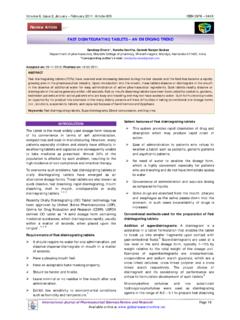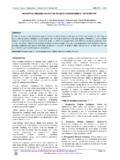Transcription of HYBRIDOMA TECHNOLOGY FOR PRODUCTION OF …
1 Volume 1, Issue 2, March April 2010; Article 017 ISSN 0976 044X International Journal of Pharmaceutical Sciences Review and Research Page 88 Available online at HYBRIDOMA TECHNOLOGY FOR PRODUCTION OF MONOCLONAL ANTIBODIES Shivanand Pandey Smt. R. B. P. M. Pharmacy College, Atkot-360040, Rajkot, Gujarat. India Email: ABSTRACT Hybridomas are cells that have been engineered to produce a desired antibody in large amounts. To produce monoclonal antibodies, B-cells are removed from the spleen of an animal that has been challenged with the relevant antigen. These B-cells are then fused with myeloma tumor cells that can grow indefinitely in culture (myeloma is a B-cell cancer). This fusion is performed by making the cell membranes more permeable. The fused hybrid cells (called hybridomas), being cancer cells, will multiply rapidly and indefinitely and will produce large amounts of the desired antibodies.
2 They have to be selected and subsequently cloned by limiting dilution. Supplemental media containing Interleukin-6 (such as briclone) are essential for this PRODUCTION of monoclonal anti-bodies was first invented by Cesar Milstein, Georges J. F. K hler and Niels Kaj Jerne in 1975. Selection occurs via culturing the newly fused primary HYBRIDOMA cells in selective-media, specifically media containing 1x concentration HAT for roughly 10 14 days. After using HAT it is often desirable to use HT containing media. Cloning occurs after identification of positive primary HYBRIDOMA cells. Clone by limited dilution. While some may believe that IL-6 is essential for this step, it is not necessary to add that expensive supplement, rather use 50% heat-inactivated FBS for the first week. Add 10% FBS DMEM to the clone culture plate after screening for single colony wells. Keywords: Hybridomas, monoclonal antibodies, Interleukin-6, Supplemental media INTRODUCTION Hybridomas are cells that have been engineered to produce a desired antibody in large amounts, to produce monoclonal antibodies.
3 (1, 2) Monoclonal antibodies can be produced in specialized cells through a technique now popularly known as HYBRIDOMA HYBRIDOMA TECHNOLOGY was discovered in 1975 by two scientists, Georges Kohler of West Germany and Cesar Milstein of Argentina (now working in ), who jointly with Niels Jerne of Denmark (now working in Germany) were awarded the 1984 Noble prize for physiology and Generally, the PRODUCTION of one MAb, using the HYBRIDOMA TECHNOLOGY , costs between $8,000 and $12,000. The average reasonably SK can generate only 15 to 30 HYBRIDOMA fusions per year, but in an environment where the focus is on diagnostic- or therapeutic-quality MAbs, there are additional significant limitations than can further decrease throughput. Monoclonal antibodies is valuable for the analysis of parasites antigen and appropriate that WHO should have organized a symposium (held at the national university of Singapore, October 1981) which brought together those who have establish and refined the TECHNOLOGY and those who are using it, or intending to use it for the study of organism responsible for some of the major diseases affecting mankind.
4 Such monoclonal antibodies, as they are known, have opened remarkable new approaches to preventing, diagnosing, and treating disease. Monoclonal antibodies are used, for instance, to distinguish subsets of B cells and T cells. This knowledge is helpful not only for basic research but also for identifying different types of leukemias and lymphomas and allowing physicians to tailor treatment accordingly. Quantitating the number of B cells and helper T cells is all-important in immune disorders such as AIDS. Monoclonal antibodies are being used to track cancer antigens and, alone or linked to anticancer agents, to attack cancer metastases. The monoclonal antibody known as OKT3 is saving organ transplants threatened with rejection, and preventing bone marrow transplants from setting off graft-versus-host disease (immune system series) METHADOLOGY A HYBRIDOMA , which can be considered as a harry cell, is produced by the injection of a specific antigen into a mouse, procuring the antigen-specific plasma cells (antibody-producing cell) from the mouse's spleen and the subsequent fusion of this cell with a cancerous immune cell called a myeloma cell.
5 The hybrid cell, which is thus produced, can be cloned to produce many identical daughter clones. These daughter clones then secrete the immune cell product. Since these antibodies come from only one type of cell (the HYBRIDOMA cell) they are called monoclonal antibodies. The advantage of this process is that it can combine the qualities of the two different types of cells; the ability to grow continually, and to produce large amounts of pure antibody. HAT medium (Hypoxanthine Aminopetrin Thymidine) is used for preparation of monoclonal antibodies. Laboratory animals (eg. mice) are first exposed to an antigen to which we are interested in isolating an antibody against. Once splenocytes are isolated from the mammal, the B cells are fused with immortalized myeloma cells - which lack the HGPRT(hypoxanthine-guanine phosphoribosyltransferase) gene - using polyethylene glycol or the Sendai virus.
6 Fused cells are incubated in the HAT (Hypoxanthine Aminopetrin Thymidine) medium. Aminopterin in the myeloma cells die, as they cannot produce nucleotides by the de novo or salvage medium blocks the pathway that allows for nucleotide synthesis. Hence, unfused D cell die. Unfused B cells die as they have a short life span. Only the Volume 1, Issue 2, March April 2010; Article 017 ISSN 0976 044X International Journal of Pharmaceutical Sciences Review and Research Page 89 Available online at B cell-myeloma hybrids survive, since the HGPRT gene coming from the B cells is functional. These cells produce antibodies (a property of B cells) and are immortal (a property of myeloma cells). 2 The incubated medium is then diluted into multiwell plates to such an extent that each well contains only 1 cell.
7 Then the supernatant in each well can be checked for desired antibody. Since the antibodies in a well are produced by the same B cell, they will be directed towards the same epitope, and are known as monoclonal Once a HYBRIDOMA colony is established, it will continually grow in culture medium like RPMI-1640 (with antibiotics and foetal bovine serum) and produce antibody (Nelson et al., 2000.)3 The next stage is a rapid primary screening process, which identifies and selects only those hybridomas that produce antibodies of appropriate specificity. The HYBRIDOMA culture supernatant, secondary enzyme labelled conjugate, and chromogenic substrate, is then incubated, and the formation of a colored product indicates a positive HYBRIDOMA . Alternatively, immunocytochemical screening can also be used (Nelson et al., Multiwell plates are used initially to grow the hybridomas and after selection, are changed to larger tissue culture flasks.)
8 This maintains the well being of the hybridomas and provides enough cells for cryopreservation and supernatant for subsequent investigations. The culture supernatant can yield 1to 60 ug/ml of monoclonal antibody, which is maintained at 20 C or lower until required (Nelson et al., 2000.)By using culture supernatant or a purified immunoglobulin preparation, further analysis of a potential monoclonal antibody producing HYBRIDOMA can be made in terms of reactivity, specificity, and cross-reactivity (Nelson et al., 2000.)3 Advancements OR Improvements in HYBRIDOMA TECHNOLOGY Considerable efforts during the last 10-15 years have been made to improve the yield of monoclonal antibodies using HYBRIDOMA technology4, 5. These efforts included the following: (6, 7) (1) The substitution of a chemical fusion promoter ( ) for the Sendai virus initially used to promote fusion, and (2) The use of myelomas that do not secrete their own antibodies and that therefore do not interfere with the PRODUCTION of the required antibody (3) A continuous cell line (Sp 2/0) was used as a fusion partner for the antibody producing B cells.
9 (4) Feeder layers consisting of extra cells to feed newly formed hybridomas were used for optimal growth and HYBRIDOMA PRODUCTION . The most common feeder layers consisted of (6, 7) murine peritoneal cells, marcrophages derived from mouse, rat or guinea pig Volume 1, Issue 2, March April 2010; Article 017 ISSN 0976 044X International Journal of Pharmaceutical Sciences Review and Research Page 90 Available online at extra non immunized spleen cells, human fibroblasts, human peripheral blood monocytes or thymus cells; these feeder cells had some limitations like depletion of nutrients meant for HYBRIDOMA and contamination, so that other sources of HYBRIDOMA growth factors (HGF) like interleukin-6 (II-6) derived from human cells were used.
10 Purification of Antibodies Monoclonal antibodies may need to be purified before they are used for a variety of purposes. Before final purification, the cultures may be subjected to cell fractionation for enrichment of the antibody protein. In E. coli, the antibodies may be secreted in the periplasm, which may be used for enrichment of antibody, so that further purification is simplified. Alternatively the antibodies may be purified from cell homogenate or cell debris obtained from the medium. (6, 7) Antibodies can be purified by anyone of the following techniques (I) ion-exchange chromatography; (ii) antigen affinity chromatography. Serum Free Media for Bulk Culture of HYBRIDOMA Cells The media for culturing a variety of animal cells and discussed the significance of adding serum to basal nutrient media. Serum is a highly complex and poorly defined mixture of components like albumin, transferrin, lipoproteins and various hormones/growth factors.













